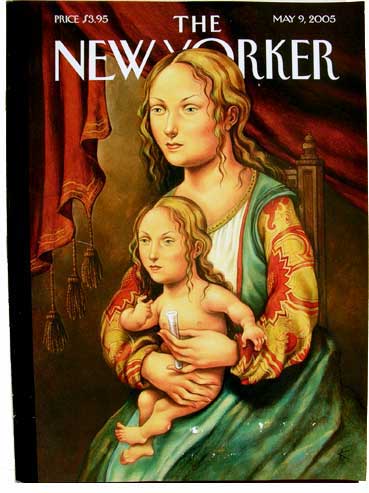Notes
Like Mother, Like Daughter

I’ve been waiting for months to do a New Yorker cover. Unfortunately, the magazine hasn’t been that political on its face this year.
(I’ll tell you just how eager I’ve been, though. If you recall, the Terri Schiavo drama came to a head right around Easter. That week, The New Yorker cover featured a pregnant bunny in a hospital bed with her bunny husband at her side. Opposite her was a bunny doctor pointing to a computer screen displaying her ultrasound. Instead of a baby bunny, however, the screen revealed an egg — an easter egg. Call it wishful thinking, but I was certain this must be some kind of pro-life commentary. Well, I spent more time than I care to admit trying to decipher the message. I kept thinking about that egg and its connection to Easter, human eggs, conception, embryos, the reputation bunnies have for procreation — all kinds of business. Finally, I had to concede the illustration was largely devoid of politics).
(…Although I did wonder what kind of insurance plan these bunnies had that would pay for a hospital room — and a private one, no less — just for an ultrasound.)
I think we could say this illustration brings The New Yorker cover back to the political fold. Having gone over it with my favorite art consultant, I’m told that the wooden chair; the elaboration of sleeve; the serious, contemplative inward gaze are all reminiscent of Renaissance portraiture, with the figures a clear reference to the Madonna and child.
If that’s the case, this illustration suggests that virgin birth is a fact. The confirmation, however, resides not in the bible, but in the domain of modern science. Just because the Madonna carries a test tube, however, does it necessarily turn this into a secular image? Maybe a point the picture makes is that science and religion are not mutually exclusive. And, why should “artificial insemination” be considered exclusive of religion, anyway? If God resides in man, couldn’t this form of conception — the miracle that it is — represent a modern day equivalent of divine intervention?
This image, though, pushes the line between science and religion much further than that. Our Renaissance Mary didn’t just have any baby — she had another Mary! That being the case, does the illustration suggest that cloning, too, is God’s will?
Given the sensitivity around these issues, it’s not surprising the illustrator hedged her bet. What I mean is, while “Mary” is as earnestly rendered and historically representative (at least, for a magazine cover) as the Mona Lisa, the child is not. With the swinging arms, the crossed feet, and the slightly cartoonish swollen calf and knobby knees, the ultimate message is: let’s not take these matters too seriously. (To which I say: Thank God!)
By the way, how would you interpret that gesture Baby Mary is making? My art friend thinks it means: “Bring it on!”
But, bring on what? Maybe the Mary clone (or the anima of Jesus, in fact) is challenging us to bring on a more easygoing relationship between the secular and the religious. Maybe it suggests bringing on sanity (as opposed to sanctity) as the reigning standard in our classrooms, courtrooms, newsrooms, playrooms, and bedrooms.
(image: “Like Mother, Like Daughter” by Anita Kunz. The New Yorker Magazine. May 9, 2005. Cover)


Reactions
Comments Powered by Disqus